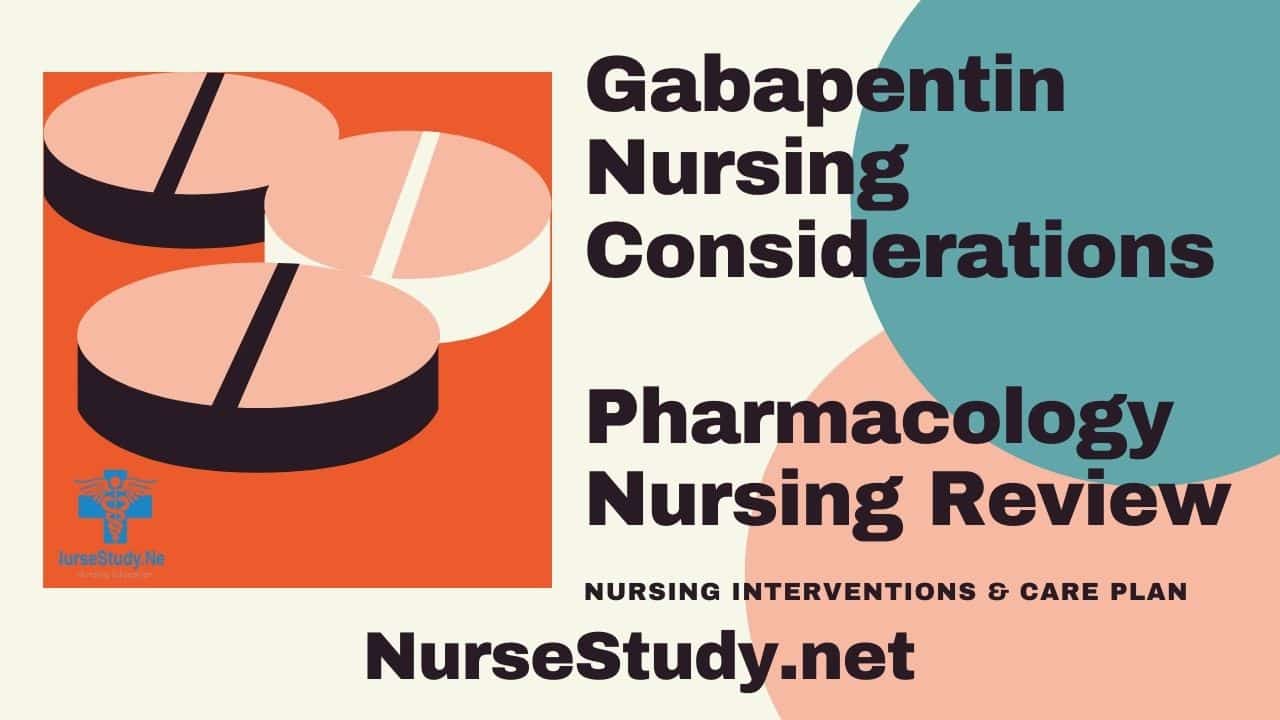Gabapentin is an anticonvulsant medication commonly prescribed for epilepsy, neuropathic pain, and various off-label uses. Understanding proper nursing considerations is crucial for safe and effective patient care.
Generic name: Gabapentin
Brand names: Neurontin, Gralise, Horizant, Gabarone
Pharmacologic class: Anticonvulsant, Antiepileptic
Therapeutic class: Anticonvulsant, Analgesic for neuropathic pain
Mechanism of action: Gabapentin’s exact mechanism remains unclear. It is structurally similar to GABA but does not bind to GABA receptors. It is believed to bind to voltage-gated calcium channels in the central nervous system, reducing the release of excitatory neurotransmitters.
Indications for use:
- Partial seizures with or without secondary generalization
- Postherpetic neuralgia
- Diabetic neuropathy
- Restless legs syndrome (Horizant)
- Off-label uses: anxiety, hot flashes, alcohol withdrawal, fibromyalgia
Precautions and contraindications:
- Hypersensitivity to gabapentin
- Renal impairment (requires dose adjustment)
- Elderly patients
- Pregnancy (Category C)
- History of substance abuse
- Patients with respiratory conditions
Drug Interactions
- Antacids containing aluminum or magnesium (reduce absorption)
- Opioids (increased sedation and respiratory depression)
- Alcohol (increased CNS depression)
- Medications affecting renal function
- Other CNS depressants
Adverse Effects
- Somnolence, dizziness, fatigue
- Peripheral edema
- Weight gain
- Ataxia, tremor
- Diplopia, blurred vision
- Mood changes, suicidal thoughts
- Memory problems, confusion
- Respiratory depression (especially with opioids)
- Nausea, dry mouth, constipation
Administration Considerations
Available preparations:
- Oral capsules: 100mg, 300mg, 400mg
- Oral tablets: 600mg, 800mg
- Oral solution: 250mg/5mL
- Extended-release tablets (Gralise): 300mg, 600mg
Typical dosages:
- Initial dose: 300mg once daily
- Maintenance: 300-600mg three times daily
- Maximum dose: 3600mg daily (divided doses)
- Must be adjusted for renal impairment
Nursing Considerations for Gabapentin
Related Nursing Diagnoses
- Risk for injury related to CNS effects
- Acute pain/Chronic pain
- Risk for falls related to dizziness and ataxia
- Deficient knowledge related to medication regimen
- Risk for non-adherence related to the complex dosing schedule
Nursing Assessment
- Perform comprehensive neurological assessment.
- Assess renal function (creatinine clearance).
- Evaluate pain levels and characteristics.
- Screen for the history of substance abuse.
- Assess fall risk.
- Monitor for suicidal ideation, especially in young patients.
- Evaluate respiratory status, particularly with concurrent opioid use.
Nursing Interventions
- Implement fall precautions due to drowsiness and dizziness.
- Monitor for and document effectiveness in pain relief or seizure control.
- Assess for and document side effects.
- Monitor for signs of abuse or dependence.
- Provide emotional support and frequent monitoring for patients at risk for suicidal ideation.
- Ensure proper hydration.
- Monitor weight regularly.
Patient Teaching Associated with Gabapentin
- Take gabapentin exactly as prescribed, at evenly spaced intervals.
- Do not stop taking gabapentin abruptly; gradual discontinuation is required.
- Avoid alcohol while taking gabapentin.
- Take antacids at least 2 hours apart from gabapentin.
- Report any unusual changes in mood or thoughts of self-harm.
- Use caution when driving or operating machinery until effects are known.
- Rise slowly from sitting or lying positions to prevent orthostatic hypotension.
- Report significant weight changes or swelling.
- Keep all follow-up appointments for monitoring.
- Maintain good oral hygiene due to dry mouth side effects.
Note: This is not an all-inclusive list of possible drug interactions, adverse effects, precautions, nursing considerations, or patient instructions. Please consult with a pharmacist for complete information.
References
- Smith, M. D., & Jones, K. L. (2023). Clinical Management of Gabapentin in Chronic Pain: A Systematic Review. Journal of Pain Management, 15(2), 45-62.
- Anderson, R. T., Williams, S., & Thompson, P. (2024). Gabapentin in Neurological Disorders: Current Evidence and Nursing Implications. Advanced Journal of Nursing Practice, 42(1), 12-28.
- Kumar, P., & Martinez, J. (2023). Safety Considerations in Gabapentin Administration: A Comprehensive Review. International Journal of Clinical Pharmacology, 38(4), 189-205.
- Chen, L., & Davis, R. (2024). Best Practices in Patient Education for Anticonvulsant Medications. Nurse Education Today, 55(3), 78-92.
- Wiffen PJ, McQuay HJ, Edwards JE, Moore RA. Gabapentin for acute and chronic pain. Cochrane Database Syst Rev. 2005 Jul 20;(3):CD005452. doi: 10.1002/14651858.CD005452. Update in: Cochrane Database Syst Rev. 2011 Mar 16;(3):CD005452. doi: 10.1002/14651858.CD005452.pub2. PMID: 16034978.
